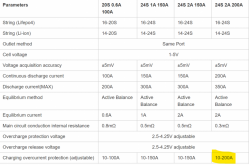Hi,
I have 18 x 280Ah cells, and have the Ah capacity set as 260Ah on both the JK & Classic apps.
I have noticed over the last 3 weeks that the indicated remaining capacity shown on the Enjpower app is falling compared to the reading on the Classic app. The Midnite Classic will usually get to 260Ah before going to Float, while the BMS app is a few Ah less. Because it never goes to 260Ah, it's falling behind the SCC. Yesterday it was about ~50Ah lower.
Just to confirm which is reading correctly (I don't want to believe the SCC, and then run out of electricity sooner than expected), lunchtime yesterday after reaching Float, I turned off solar to both the SCC & the inverter/SCC. Also switched off the grid input to the inverter. I'm going to run the bank down until either it reaches 48V, or the BMS shuts off discharge at 2.6V on any cell. I have an ATS, so the grid will supply the house when the inverter or BMS shuts down.
This morning @ 8am, the BMS app indicated 0Ah, the Classic 44Ah remaining. Bank was down to 58V BMS, 57.5V SCC., inverter 58.6V.
I don't know if it's the updated app, but previously I'm sure the 2 values were roughly the same after the charge cycle. I may try the earlier app in a couple of days and see if it's the same.
Wondering if anybody else has notice this.
I have a 3rd Ah meter, but currently

it's in the cable to the inverter and only measures what is going in/out of that. I'll move it to the BMS cable soon, and see if that's reading the same as the SCC (WBJr Ah shunt).
dRdoS7




